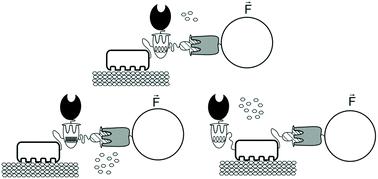当前位置:
X-MOL 学术
›
Biomater. Sci.
›
论文详情
Our official English website, www.x-mol.net, welcomes your
feedback! (Note: you will need to create a separate account there.)
Impact of scaffoldin mechanostability on cellulosomal activity.
Biomaterials Science ( IF 5.8 ) Pub Date : 2020-03-20 , DOI: 10.1039/c9bm02052g Albert Galera-Prat 1 , Andrés M Vera , Sarah Moraïs , Yael Vazana , Edward A Bayer , Mariano Carrión-Vázquez
Biomaterials Science ( IF 5.8 ) Pub Date : 2020-03-20 , DOI: 10.1039/c9bm02052g Albert Galera-Prat 1 , Andrés M Vera , Sarah Moraïs , Yael Vazana , Edward A Bayer , Mariano Carrión-Vázquez
Affiliation

|
Lignocellulose is the most abundant renewable carbon source in the biosphere. However, the main bottleneck in its conversion to produce second generation biofuels is the saccharification step: the hydrolysis of lignocellulosic material into soluble fermentable sugars. Some anaerobic bacteria have developed an extracellular multi-enzyme complex called the cellulosome that efficiently degrades cellulosic substrates. Cellulosome complexes rely on enzyme-integrating scaffoldins that are large non-catalytic scaffolding proteins comprising several cohesin modules and additional functional modules that mediate the anchoring of the complex to the cell surface and the specific binding to its cellulosic substrate. It was proposed that mechanical forces may affect the cohesins positioned between the cell- and cellulose-anchoring points in the so-called connecting region. Consequently, the mechanical resistance of cohesins within the scaffoldin is of great importance, both to understand cellulosome function and as a parameter of industrial interest, to better mimic natural complexes through the use of the established designer cellulosome technology. Here we study how the mechanical stability of cohesins in a scaffoldin affects the enzymatic activity of a cellulosome. We found that when a cohesin of low mechanical stability is positioned in the connecting region of a scaffoldin, the activity of the resulting cellulosome is reduced as opposed to a cohesin of higher mechanical stability. This observation directly relates mechanical stability of the scaffoldin-borne cohesins to cellulosome activity and provides a rationale for the design of artificial cellulosomes for industrial applications, by incorporating mechanical stability as a new industrial parameter in the biotechnology toolbox.
中文翻译:

支架蛋白机械性能对纤维素酶活性的影响。
木质纤维素是生物圈中最丰富的可再生碳源。然而,转化为生产第二代生物燃料的主要瓶颈是糖化步骤:将木质纤维素材料水解为可溶性可发酵糖。一些厌氧细菌已开发出一种称为纤维素小体的细胞外多酶复合物,该复合物可有效降解纤维素底物。纤维素复合物依赖于酶整合的支架蛋白,该酶是大型的非催化支架蛋白,包含几个黏附蛋白模块和其他功能模块,这些模块介导复合物锚定到细胞表面以及与纤维素基质的特异性结合。已经提出,机械力可以影响位于所谓的连接区域中的细胞锚定点和纤维素锚定点之间的粘着蛋白。因此,支架蛋白内的粘着蛋白的机械抗性对于理解纤维素体的功能和作为工业利益的参数,以通过使用已建立的设计的纤维素体技术更好地模拟天然复合物都是非常重要的。在这里,我们研究支架蛋白中黏着蛋白的机械稳定性如何影响纤维素酶的酶活性。我们发现,当将低机械稳定性的粘着蛋白置于支架蛋白的连接区域中时,与较高机械稳定性的粘着蛋白相反,所得纤维素体的活性降低。
更新日期:2020-03-20
中文翻译:

支架蛋白机械性能对纤维素酶活性的影响。
木质纤维素是生物圈中最丰富的可再生碳源。然而,转化为生产第二代生物燃料的主要瓶颈是糖化步骤:将木质纤维素材料水解为可溶性可发酵糖。一些厌氧细菌已开发出一种称为纤维素小体的细胞外多酶复合物,该复合物可有效降解纤维素底物。纤维素复合物依赖于酶整合的支架蛋白,该酶是大型的非催化支架蛋白,包含几个黏附蛋白模块和其他功能模块,这些模块介导复合物锚定到细胞表面以及与纤维素基质的特异性结合。已经提出,机械力可以影响位于所谓的连接区域中的细胞锚定点和纤维素锚定点之间的粘着蛋白。因此,支架蛋白内的粘着蛋白的机械抗性对于理解纤维素体的功能和作为工业利益的参数,以通过使用已建立的设计的纤维素体技术更好地模拟天然复合物都是非常重要的。在这里,我们研究支架蛋白中黏着蛋白的机械稳定性如何影响纤维素酶的酶活性。我们发现,当将低机械稳定性的粘着蛋白置于支架蛋白的连接区域中时,与较高机械稳定性的粘着蛋白相反,所得纤维素体的活性降低。











































 京公网安备 11010802027423号
京公网安备 11010802027423号